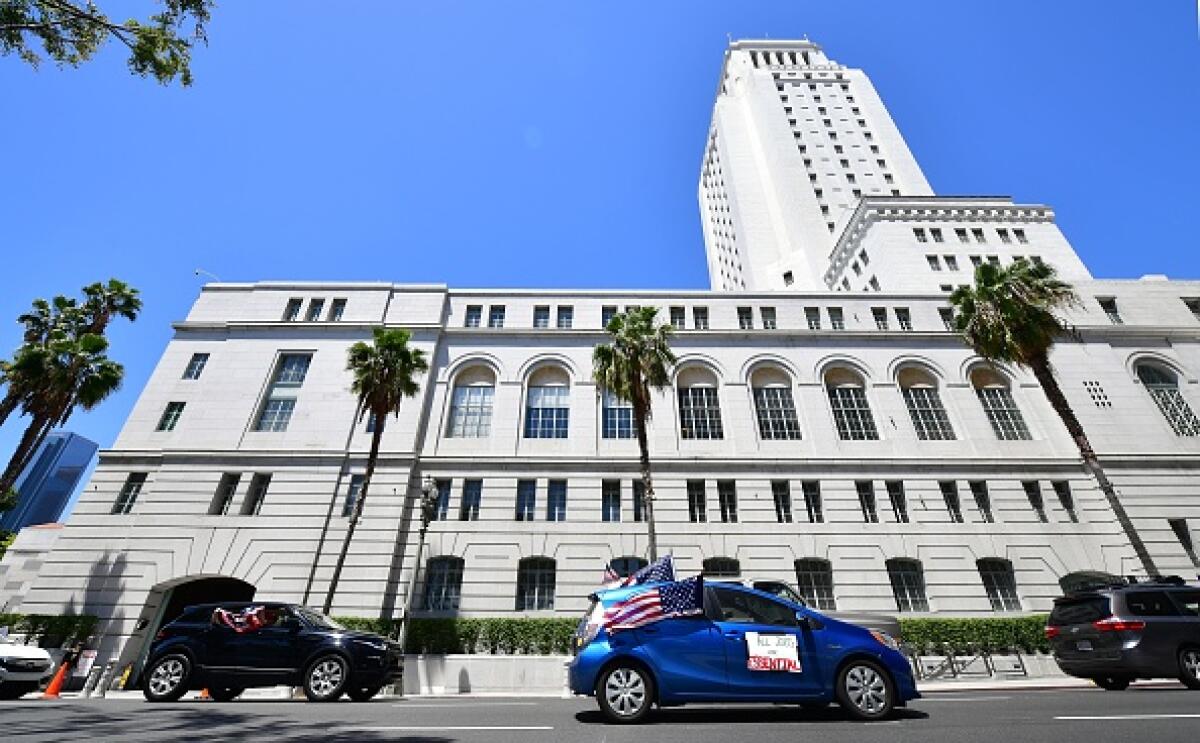Editorial: In Los Angeles, political meddling poisons redistricting

- Share via
Let’s be clear: The Los Angeles City Council Redistricting Commission is not independent.
The city panel has little in common with California’s somewhat randomly selected, fully independent and bipartisan citizens commission that will redraw congressional and state legislative districts without fear of being overridden by the Legislature, or with Los Angeles County’s redistricting commission, which bans former elected officials and political operatives from serving. Those are independent citizens commissions that will decide political boundaries and representation without meddling from people who want to stay in office or run for office.
Though it purports to be an independent citizens panel, L.A.’s commission is something else entirely. Commissioners include former elected officials and longtime political aides, who are appointed by the city’s elected leaders and serve at their pleasure. The City Council, not the commission, has the final say on the district maps. This quasi-independent system was approved by voters in 1999 before actually independent redistricting became more widely embraced.
This was supposed to be an improvement on the old-school method of redrawing political boundaries, in which elected officials would get together in back rooms to negotiate district boundaries among themselves and then adopt the new map in public. Los Angeles is now in its third round of “citizen” redistricting, and it should be clear by now that the system is fundamentally flawed in ways that erode public trust and discourage civic participation. The commission approved its final map last week on a 15-6 vote, and it goes to the City Council for more public hearings and a vote before the end of the year.
Although some commissioners legitimately tried to make their work as evenhanded and independent as possible, others followed the unwritten rule of L.A. redistricting, which is that commissioners are there to do the bidding of the elected official who put them there. The public is led to believe this is an independent, impartial body drawing lines for the greater good. But there’s nothing within the charter or the commission rules that require impartiality, and when so much is at stake, a council member would be a sucker for not wielding the power he or she has.
Consider the experience of Councilwoman Nithya Raman, the progressive newcomer who ousted incumbent Councilman David Ryu in November. Before his defeat, Ryu had already selected former City Councilman Mike Woo as his redistricting commissioner. Woo resigned from the commission so Raman could make her own appointment, but he offered her some advice on how to approach the process.
“Because political self-interest is the dominating factor in redistricting, there is considerable risk of treachery. You can’t really trust any of the other participants unless you understand their self-interest,” Woo wrote in an email later published on the blog MichaelKohlhaas.org. “Equity and justice are typically not factors in redistricting except to the extent that Federal civil rights statutes protect representation of certain ‘classes.’”
Raman, who ran as a City Hall outsider, dismissed his advice and picked longtime social justice activist Alexandra Suh as her commissioner. But Woo’s warning was prescient. Suh was effectively steamrolled by a bloc of longtime political insiders, who pushed a map that radically redesigned Raman’s District 4, along with Councilman Paul Krekorian’s District 2, so much so that the newly elected councilwoman could end up in an entirely new district halfway across the city.
In a last-minute effort to save her district, Raman swapped out Suh for Jackie Goldberg, an L.A. school board member and former councilwoman who is the consummate political fighter. By then it was too late. The commission’s approved map hacked up CD 4 and CD 2, without even deciding which council person should represent each district.
Would Raman’s district have been upended if the city had an independent commission? It’s possible — redistricting can lead to dramatically different districts for good reasons. But as long as Los Angeles allows political interference and behind-the-scenes lobbying, it’s impossible for people to have faith in the process or trust the commission’s decisions.
And that’s the problem. The nature of the commission leaves residents questioning the motives behind controversial line-drawing decisions. Why were poorer communities in the west San Fernando Valley cut out of Council District 3? Why was USC moved into Council District 8 and then back to Council District 9 the next day? Why were some district boundaries barely touched and others completely redrawn?
The City Council could have done more to insulate the commission from undue political influence. It did not adopt a ban on all private conversations with commissioners to prevent backroom deals. The council did not adopt a formal removal process for commissioners, so elected officials couldn’t yank their appointees when they weren’t happy with the line-drawing — which is what happened in the final weeks of the commission’s work in at least one case, and possibly others.
Even under the best circumstances, redistricting in Los Angeles is a nearly impossible job. It requires dividing a city of nearly 4 million people into 15 council districts, while trying to honor the wishes of various ethnic, religious and socioeconomic groups. The least we could do is make the system more trustworthy and transparent. As soon as this redistricting cycle is done, we hope to see work on a ballot measure to change the charter before the next one in 10 years. It’s time for Los Angeles to have a truly independent citizens redistricting commission.
More to Read
A cure for the common opinion
Get thought-provoking perspectives with our weekly newsletter.
You may occasionally receive promotional content from the Los Angeles Times.










